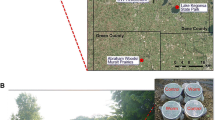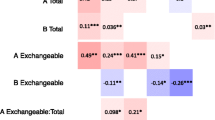Summary
Populations of exotic earthworms responded positively to the presence of the nitrogen-fixing tree, Myrica faya, which is currently invading early succesional habitats in Hawaii Volcanoes National Park. Earthworm biomass in one high-density stand of Myrica was over three times the levels in nearby submontane forest and rainforest. Comparisons of earthworm populations under pairs of Myrica and the dominant native tree, Metrosideros polymorpha, showed biomass levels to be elevated from over two- to almost eightfold under the exotic tree. The increased rate of burial of nitrogenrich litter by earthworms can alter the rate of nitrogen accretion and cycling in these ecosystems.
Similar content being viewed by others
References
Abbott I, Parker CO (1981) Interactions between earthworms and their soil environment. Soil Biol Biochem 13:191–197
Cuendet G (1984) A comparative study of the earthworm population of four different woodland types in Wytham woods, Oxford. Pedobiologia 26:421–439
Darwin C (1881) The formation of vegetable mould through the action of worms with observations on their habits. John Murray, London
Devore JL (1982) Probability and statistics for engineering and the sciences. Brooks/Cole, Monterey
Elton CS (1958) The ecology of invasions by animals and plants. John Wiley and Sons, New York
Gates GE (date unknown) Preservation of earthworms. Pamphlet of the Museum of Comparative Zoology, Harvard University, Cambridge Massachusetts
Giambelluca TW, Nullet MA, Schroeder TA (1986) Rainfall atlas of Hawaii. Report R76, Division of Water and Land Development, Department of Land and Natural Resources, State of Hawaii
Guild WJMcL (1952) Variation in earthworm numbers within field populations. J Anim Ecol 21:169–181
Herlizius H (1987) Decomposition in five woodland soils: relationships with some invertebrate populations and with weather. Biol Fertil Soils 3:85–89
James SW, Seastedt TR (1986) Nitrogen mineralization by native and introduced earthworms: effects on big bluestem growth. Ecology 67:1094–1097
Lee KE (1985) Earthworms: their ecology and relationships with soils and land use. Academic Press. Sydney
Mooney HA, Drake JA (1986) Ecology of biological invasions of North America and Hawaii. Springer, Berlin Heidelberg New York
Nakamura M (1981) Some observations on occurrence of earthworms in forest habitats. Ekol Pol 29:97–115
Neuhauser EF, Hartenstein R, Kaplan DL (1980) Growth of the earthworm Eisenia foetida in relation to population density and food rationing. Oikos 35:93–98
Satchell JE, Lowe DG (1967) Selection of leaf litter by Lumbricus terrestris. In: Graf O, Satchell JE (eds) Progress in soil biology. (Proceedings of the colloquium on dynamics of soil communities). Fr Vieweg Braunschweig, pp 102–119
Scheu S (1987) The influence of earthworms (Lumbricidae) on the nitrogen dynamics in the soil litter system of a deciduous forest. Oecologia 72:197–201
Stone CP, Stone DB (1989) Conservation biology in Hawaii. Cooperative National Park Resources Studies Unit, University of Hawaii, Manoa, Honolulu
Syers JK, Sharpley AN, Keeney DR (1979) Cycling of nitrogen by surface-casting earthworms in a pasture ecosystem. Soil Biol Biochem 11:181–185
Torchio PF (1987) Use of non-honey bee species as pollinators of crops. Proc Ent Soc Ontario 118:111–124
Vitousek PM, Walker LR (1989) Biological invasion by Myrica faya in Hawaii: plant demography, nitrogen fixation, and ecosystem effects. Ecol Monogr 59:247–265
Vitousek PM, Van Cleve K, Balakrishnan N, Mueller-Dombois D (1983) Soil development and nitrogen turnover in montane rainforest soils on Hawaii. Biotropica 15:268–274
Vitousek PM, Walker LR, Whiteaker LD, Mueller-Dombois D, Matson PA (1987) Biological invasion by Myrica faya alters ecosystem development in Hawaii. Science 238:802–804
Author information
Authors and Affiliations
Rights and permissions
About this article
Cite this article
Aplet, G.H. Alteration of earthworm community biomass by the alien Myrica faya in Hawai'i. Oecologia 82, 414–416 (1990). https://doi.org/10.1007/BF00317491
Received:
Revised:
Accepted:
Issue Date:
DOI: https://doi.org/10.1007/BF00317491




